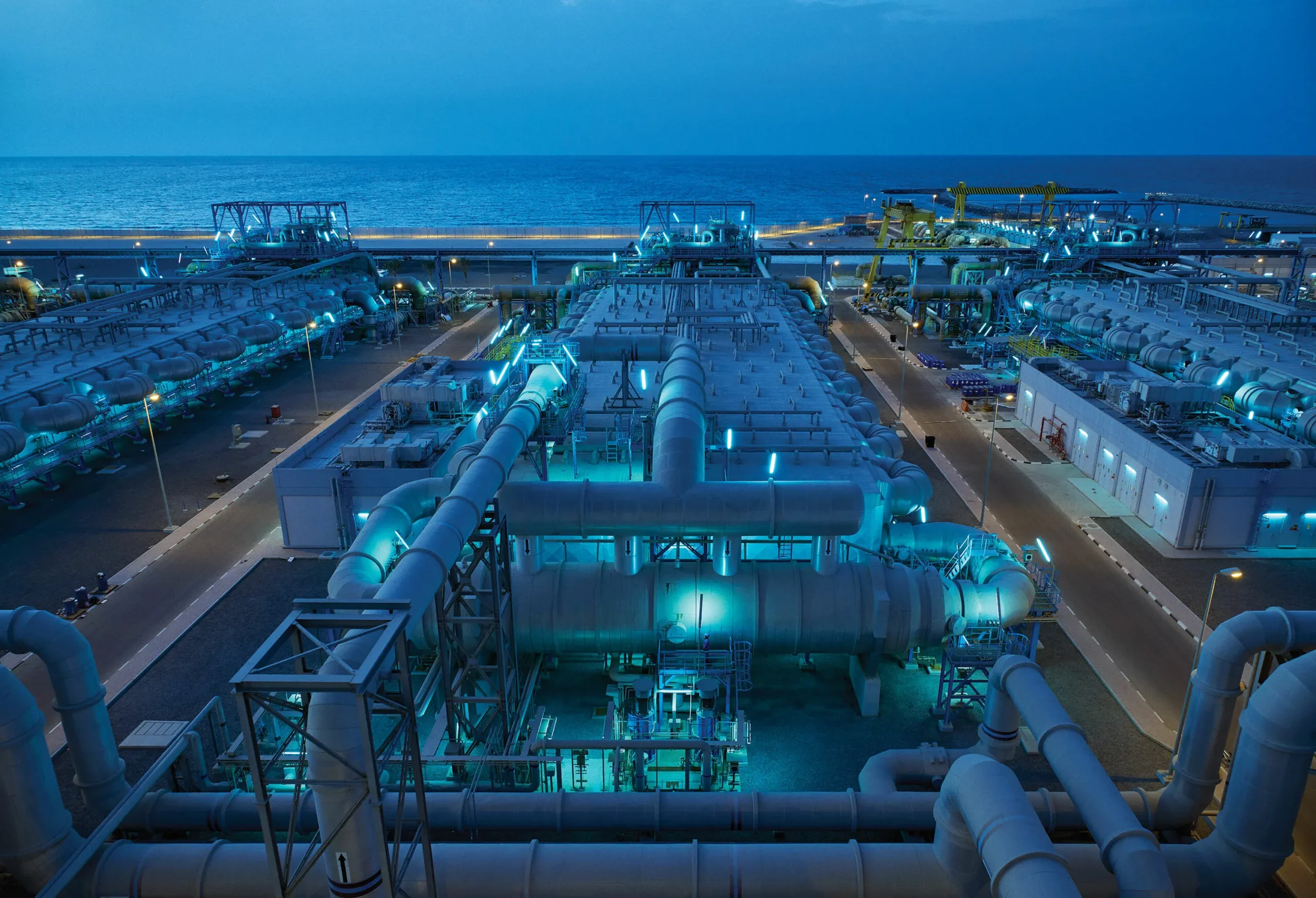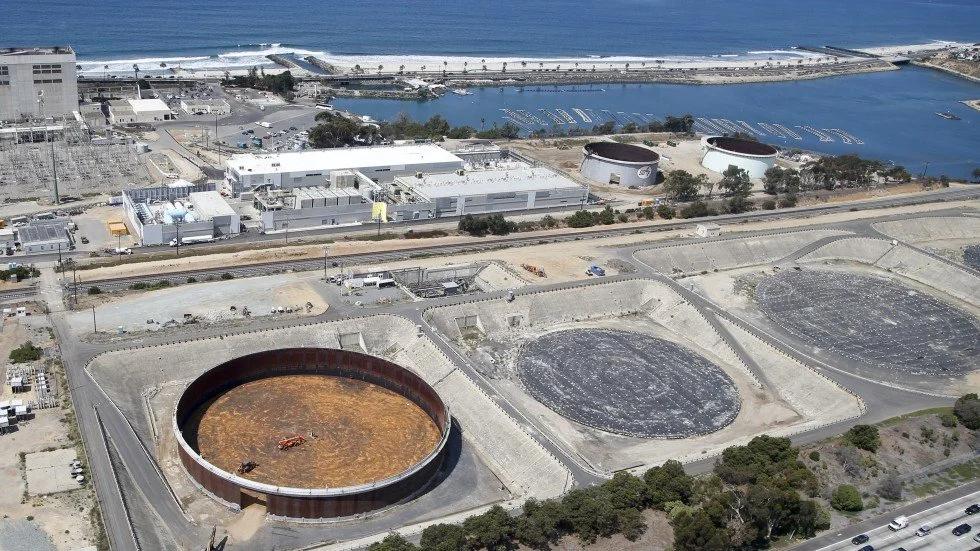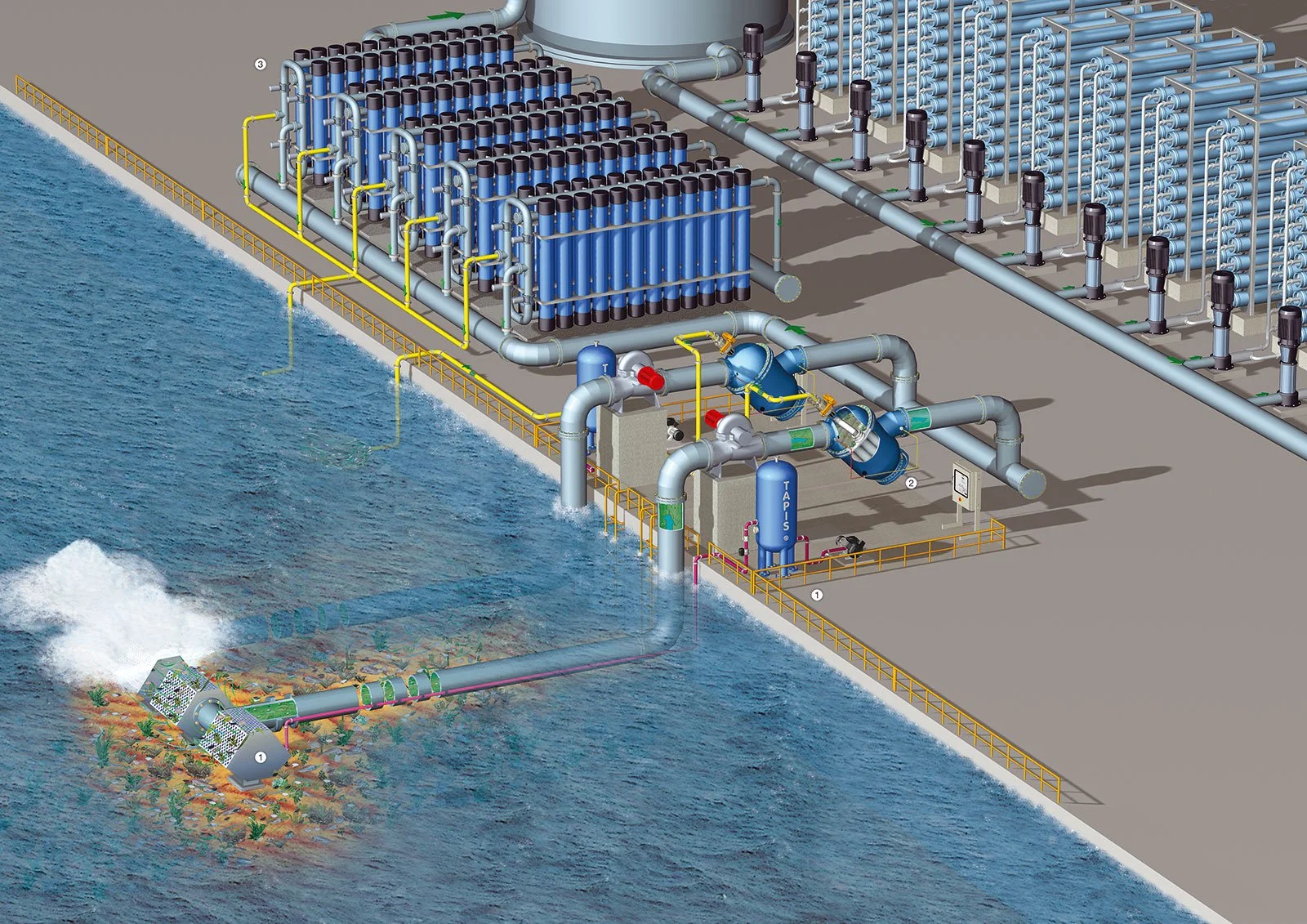Desalination Plants and their Environmental Impacts
Written by: Gianna Hector
Edited by: Ailin Bogers
Desalination plants are industrial facilities that remove salts and other minerals from seawater to produce fresh, potable water. These desalination plants typically operate in one of two ways. They either use distillation, which employs heat to evaporate and condense water. Or by reverse osmosis (RO), which uses semipermeable membranes (a physical or biological barrier that selectively permits the passage of some molecules or ions while blocking others, usually based on their size and charge) and high-pressure pumps to filter out impurities. This process is key to providing communities, especially those by the coast, with safe drinking water that is drought-resistant. This is especially crucial for regions facing water scarcity due to limited natural freshwater reserves or declining groundwater levels. Whilst the operation of desalination plants is meant to help people, there are still detrimental environmental impacts that can't be ignored. So, what are they?
Brine Discharge
One of the most problematic effects of desalination plants is the immense amount of brine discharged. The process of producing freshwater leaves behind a highly concentrated brine mixed with chemicals, which can be difficult to dispose of. The result is often brine discharge, where the concentrated saltwater (i.e. brine) is released back into the oceanic environment, which alters the ocean’s delicate osmotic balance and negatively impacts aquatic life. The brine increases the salinity of the ocean, thereby reducing oxygen levels and creating ‘dead zones’, which is very harmful to marine life. A study by Science of the Total Environment on desalination plants worldwide revealed that these facilities generate around 95 million cubic meters of freshwater, but also 141.5 million cubic meters of brine. This is 50% more brine than predicted. This is a significant issue as brine contains hazardous chemicals like chlorine and copper. Additionally, the salt content of the brine is 5%, whereas the average for saltwater is just 3.5%. Marine life now has to adapt to be able to withstand altered waters, but if the seawater becomes too salty, these creatures may just die.
Mortality of Marine Species and Intake Mechanisms
Another challenge desalination facilities face is water supply. Large amounts of seawater must be transported into the facility daily to generate freshwater. It is often overlooked that the desalination process involves the absorption and death of tiny prey such as plankton, fish eggs, larvae, and even small fish. The effect, commonly referred to as "impingement and entrainment", can have a major impact on marine food webs. Even if they are not as important as individual organisms, their combined significance cannot be understated. For instance, plankton are essential to the world's carbon cycle and serve as the basis of the marine food chain. Their loss diminishes the food supply available to larger animals such as fish, marine mammals and seabirds. This would ultimately lead to fewer fish, which would have an impact on both biodiversity and the fishing sector. The coast of California, where desalination has been a topic of discussion for a long time, is a great illustration. According to environmental organizations, the intake systems of planned facilities would harm marine life, which would counteract efforts to conserve endangered coastal ecosystems.
Climate Change and Energy Use
As desalination requires a large amount of energy to operate, it consumes a lot of electricity. Desalinating water, particularly through the use of reverse osmosis, necessitates a considerable expenditure in infrastructure and high-pressure pumps, as well as the usage of a substantial amount of power. Our overreliance on fossil fuels for the majority of the power supply often results in the immediate emission of greenhouse gases. The issue is prominent in countries that desalinate a large amount of water, such as the United Arab Emirates and Saudi Arabia. These facilities use the energy generated by the burning of oil and natural gas which raises local carbon signatures as well as contributes to global climate change. What is ironic is that desalination is often used to address water scarcity exacerbated by the climate crisis. Furthermore, climate change complicates the process of desalination due to the changing water quality caused by rising sea levels and warming oceans; the quantity of energy required to treat seawater might occasionally rise. It is clear that desalination will continue to be a part of a vicious cycle with a negative environmental impact unless it is shifted in the direction where environmental cost is taken into account and renewable energy is used.
Hazardous and Chemical Waste Contamination
To maintain the effectiveness of their operations, desalination facilities employ a variety of chemicals. These include coagulants to remove impurities, anti-scaling agents to prevent mineral accumulation and chlorine for disinfection. These chemicals, which are essential for operation, often end up in the wastewater that is released into the sea. These substances have a significant impact on marine ecosystems. For instance, even small amounts of chlorine can be harmful to the majority of aquatic species. It also has the potential to create hazardous byproducts that persist in the environment when mixed with organic materials. Moreover,anti-scaling compounds change the chemical composition of seawater, posing a further threat to biodiversity. The buildup of these pollutants over time disrupts water quality and impairs the capacity of marine ecosystems to adapt. The consequences of desalination plants even affect nearby communities. If caution is not used, it has the potential to harm nearby beaches, fishing and even aquifers –the presumed solution to the water crisis may, in reality, lead to a completely new set of social and environmental challenges.
Confronting the Consequences: Is Desalination Feasible?
The world is not going to give up on desalination technology, despite the several challenges it is now facing. Desalination is viewed as a necessity in many nations, particularly those in arid regions that lack freshwater. The major concern here is whether its catastrophic effects on the environment can be mitigated and better controlled. One of the most critical measures is to enhance brine management. Plants can help limit the harm caused by poor brine disposal by diluting it with other waste streams or distributing it over a wider area. Some technologies even attempt to transform waste into a resource by extracting valuable minerals from brine. Using renewable energy sources to power desalination facilities is another promising solution. Solar desalination, for instance, has been effectively tested in Australia and North Africa. Additionally, wind and geothermal energy have the potential to reduce our dependence on fossil fuels and the negative effects of desalination on the environment and climate change. To protect marine life, new intake designs are being developed that minimise the capture of organisms. By drawing water from the ocean floor rather than directly from the open sea, subsurface intakes clearly filter out plankton and larvae, lowering mortality. The systems will eventually have positive environmental outcomes, even though they have a higher cost upfront.
Finally, the regulations governing the release and usage of chemicals must be stricter. Governments and international organizations must establish laws to reduce harmful emissions and encourage businesses to use cleaner alternatives. In an effort to make the production of freshwater more sustainable, research into environmentally friendly treatment methods must take precedence. Whilst water scarcity is increasingly threatening as our planet warms, desalination facilities are not a panacea. If left unchecked, these issues could lead to the demise of the very people and ecosystems that desalination is meant to benefit. However, with a firm dedication to sustainability, the adoption of new technology, and sound management techniques, drawbacks can be managed. Although it is impossible to eliminate the environmental costs of desalination, it may be integrated into society in a more balanced and responsible way.
References
Banerjee, P. (2025) ‘A review of reject brine disposal, management, and impacts’, Buildings, 15(13), 2317. Available at: https://doi.org/10.3390/buildings15132317
Greenmatters (2022) ‘Does Desalination Negatively Impact the Environment?’, Greenmatters, 9 December. Available at: https://www.greenmatters.com/big-impact/desalination-negative-environmental-impacts
Jones, E., Qadir, M., van Vliet, M.T.H., Smakhtin, V. and Kang, S. (2019) The state of desalination and brine production: A global outlook. Hamilton, Canada: United Nations University Institute for Water, Environment and Health (UNU-INWEH). Available at: https://drive.google.com/file/d/1KZxjEYk01HEdmDhsLmF4RzV5UXu-mwBd/view
Missimer, T.M. (2018) ‘Environmental issues in seawater reverse osmosis’, Desalination, 434, pp. 157–171. Available at: https://doi.org/10.1016/j.desal.2017.09.017
Panagopoulos, A. (2020) ‘Environmental impacts of desalination and brine treatment’, Marine Pollution Bulletin, 161, p. 111751. Available at: https://www.sciencedirect.com/science/article/abs/pii/S0025326X20308912
Sola, I. (2024) ‘Assessment of brine discharges dispersion for sustainable management’, Marine Pollution Bulletin, [online]. Available at: https://www.sciencedirect.com/science/article/pii/S0025326X24008828



